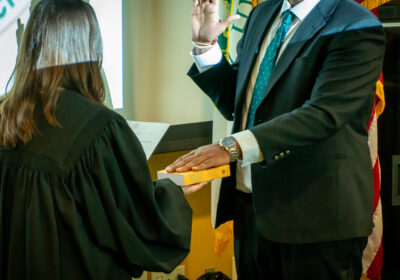Doctors attempt to heal through hypnosis
Dr. Philip Shenefelt, a professor at USF College of Medicine’s department of dermatology and a dermatologist at the James A. Haley Veterans’ hospital, sometimes uses an unconventional method to treat ailments ranging from uncontrolled chronic pain to weakened immune systems that make it hard for warts to go away: hypnosis.
But the technique is not quite the dangling of a locket in front of someone’s eyes that one may imagine.
The brain has four main states of consciousness: alert/awake, trance, dream and deep sleep, Shenefelt said. The trance state — or the state one may experience after reading a book or watching a movie and then realizing they can’t recall what they just saw — can be used to help facilitate hypnosis and treat several medical conditions.
“There are misperceptions based on movies about the hypnotist controlling the person being hypnotized,” Shenefelt said. “It’s not a valid thing that happens with hypnosis. The term hypnosis has almost a pejorative scent to it.”
As a teenager growing up in Wisconsin in the 1960s, Shenefelt said he “had a curiosity” about meditation and hypnosis, and obtained several self-help books on both topics, but it wasn’t until the 1990s — a little more than two decades after graduating from medical school — that Shenefelt had the opportunity to learn the technique at a workshop held by the American Society of Clinical Hypnosis.
Usually conducted in an exam room, each hypnosis session lasts approximately 20 minutes.
Before entering the trance state, Shenefelt said patients usually hear the following words:
“You’ll experience something where you will still be aware. And you will still have control, but your conscious will not—it will be set aside—and your subconscious will be in control. You can come out of trance at any time.”
Along the way, Shenefelt will help the person learn self-hypnosis.
“There’s an eye roll technique that usually induces hypnosis in about a minute or less,” he said. “It requires some homework on the part of the person. The person needs to be motivated to allow hypnosis to give them their full effect.”
Shenefelt said he doesn’t use hypnosis as the first option, and sometimes hypnosis doesn’t work for all patients.
“I use conventional treatments first,” he said. “If the conventional treatments don’t do enough then I consider an alternative treatment such as hypnosis. There are some people that get no benefit,” he said. “There are some that get tremendous benefit, and most people are in between.”
If hypnotherapy has been deemed the appropriate treatment option, he said, the therapy has to be conducted over the course of multiple sessions.
“Typically you don’t rewire the nervous system with one session,” Shenefelt said. “It typically takes 30 to 40 times to change a habit or sensation.
Shenefelt’s patients vary in terms of age and ailment.
“I see an age range in my clinic of infants to people in their 90s,” he said.
As long as the patient has the ability to understand language, they have the ability to be hypnotized, he said.
Dr. Eleanor Laser, a psychologist in Chicago, also utilizes hypnosis with her patients. She met Shenefelt at an American Society of Clinical Hypnosis conference a few years ago.
Together, they now co-present hypnosis workshops at conventions.
While Laser and Shenefelt practice in different fields of medicine, both experience cases that coincide.
Twenty years ago, Laser used hypnosis to help a patient break his smoking habit. Last year, she received a call from the same patient. He was experiencing a debilitating, prickly sensation in his feet; it was so bad, he couldn’t work. In an attempt to relieve the pain, he stood for hours in a bathtub filled with cold water and ice.
“He went to multiple doctors, here in Chicago,” Laser said. “But no one could help him.”
He then met laser and mentally took her back to a recent vacation to the Dominican Republic. His mind took him to a specific restaurant, and he saw the menu.
“I asked him to point to the item he ordered on the menu,” she said. “He ate the grouper.”
Grouper, she said, swim near a red coral reef that emits toxic poison that the fish absorbs.
“You can’t cook it away.”
She diagnosed him with ciguatera, a foodborne illness. Laser called Shenefelt to tell him about the case.
He didn’t believe her at first, she said.
Since she knew the problem, she was able to successfully use hypnosis to relieve the man of his symptoms.
Laser used a form of hypnosis called memory regression.
The purpose is to help the patient realize when the symptoms first manifested, and locate the origin on their body.
“Take us back to where it originally started,” she tells her patients.
By finding the memory, she said she has the ability to “neutralize the memory and eliminate the symptoms.”
Both doctors co-authored and published a case study about the ciguatera diagnosis, and the successful hypnosis treatment.
It will be presented this March in San Diego at the national American Society of Clinical Hypnosis conference.






